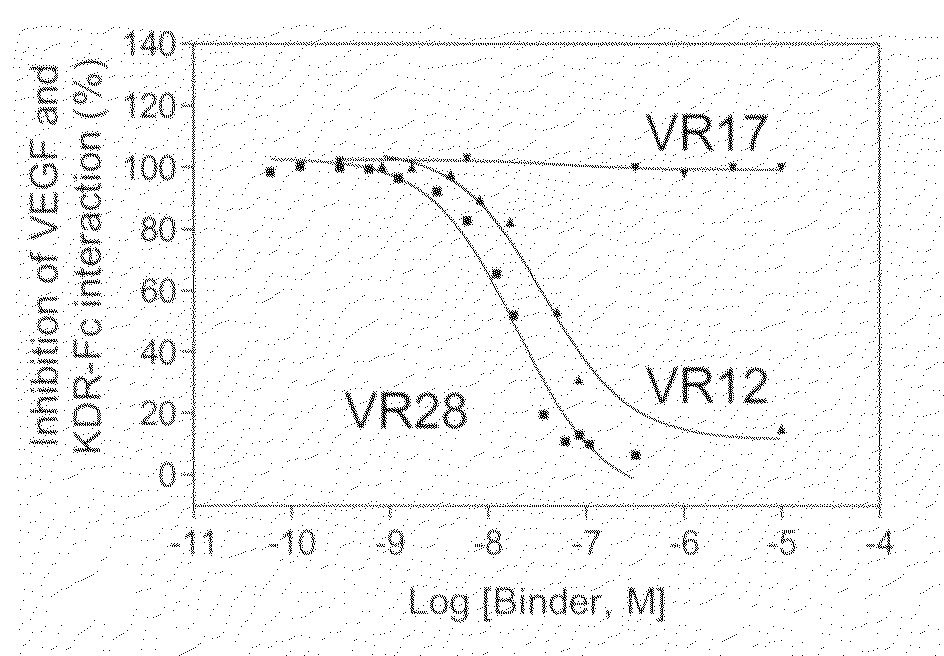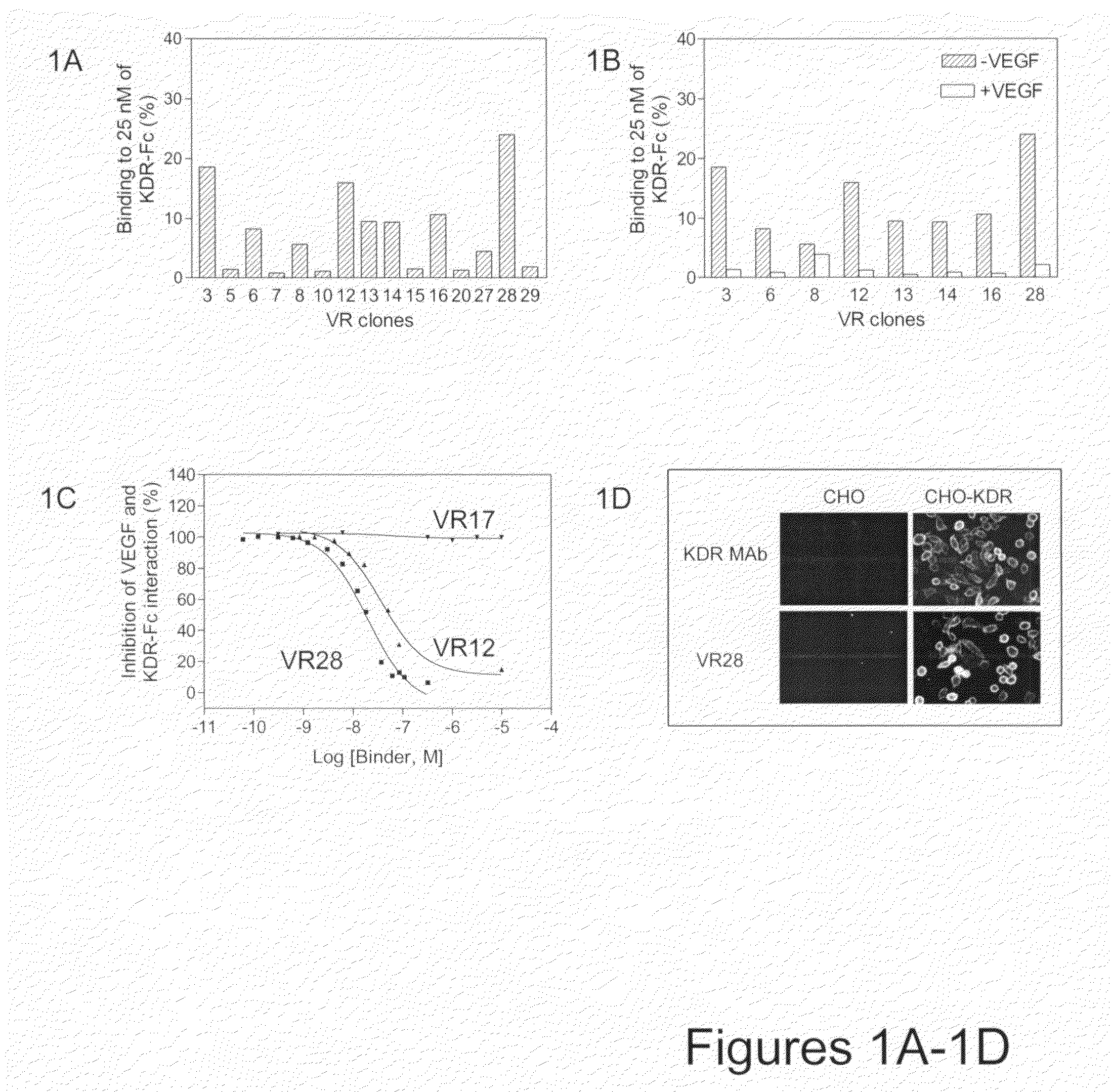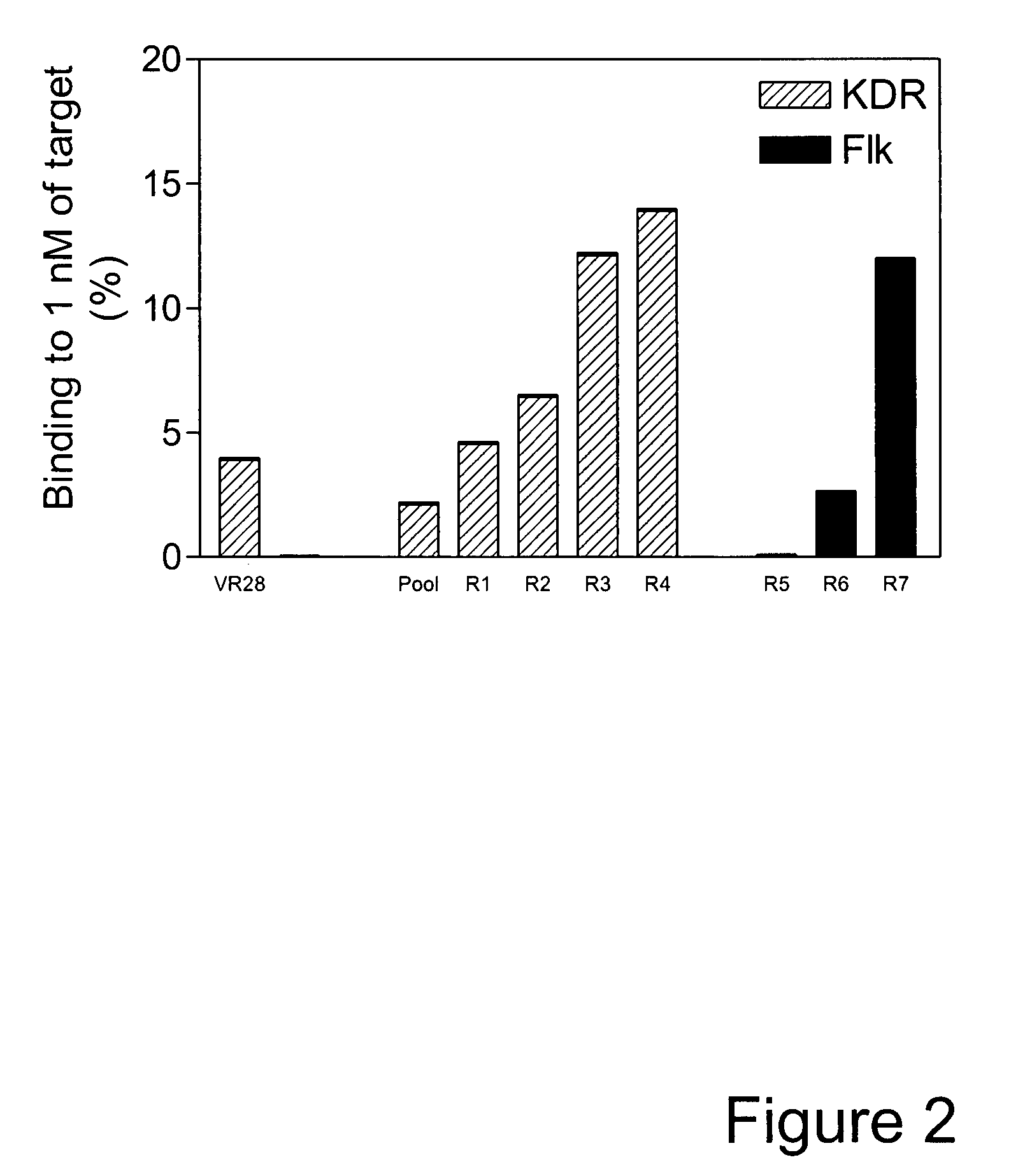Compositions and methods for intraocular delivery of fibronectin scaffold domain proteins
a technology of fibronectin and scaffold domain, which is applied in the direction of antibody medical ingredients, peptide/protein ingredients, prosthesis, etc., can solve the problems of dry macular degeneration, severe limited vision, and oxygen toxicity of prematurity retinopathy, etc., to facilitate protein purification, improve pharmacokinetics, and increase bioavailability
- Summary
- Abstract
- Description
- Claims
- Application Information
AI Technical Summary
Benefits of technology
Problems solved by technology
Method used
Image
Examples
example 1
Initial Identification of KDR Binding Molecules
[0182]A library of approximately 1013 RNA-protein fusion variants was constructed based on the scaffold of the tenth type 3 domain of human fibronectin with three randomized regions at positions 23-29, 52-55 and 77-86 (amino acid nos. are referenced to SEQ ID NO:5) (three loop library; Xu et al, Chemistry & Biology 9:933-942, 2002). Similar libraries were constructed containing randomized regions only at positions 23-29 and 77-86 (two loop library) or only at positions 77-86 (one loop library). A mixture of these three libraries was used for in vitro selection against the extracellular domain of human VEGFR-2 (KDR, extracellular domain, residues 1-764 fused to human IgG1 Fc). For the purposes of this application, the amino acid positions of the loops will be defined as residues 23-30 (BC Loop), 52-56 (DE Loop) and 77-87 (FG Loop). The target binding population was analyzed by DNA sequencing after six rounds of selection and was found to...
example 2
Affinity Maturation of Clone VR28
[0184]A mutagenesis strategy focusing on altering sequences only in the binding loops was employed. To initially test which loops were more likely to result in improvement, loop-directed hypermutagenic PCR was carried out to introduce up to 30% mutations independently into each loop of VR28. After three rounds of selection against KDR, multiple clones with improved binding to KDR-Fc were observed. Sequence analysis of the selection pools revealed that the majority of mutations were accumulated in the FG loop while the BC and DE loops remained almost intact. This result indicated that the FG loop was the most suitable target for further modification.
[0185]Consequently, a new library of approximately 1012 variants was constructed by altering the sequence of VR28 in the FG loop using oligonucleotide mutagenesis. For each of the FG loop positions (residues 77-86 [VAQNDHELIT (SEQ ID NO:198)] as well as the following Proline [residue 87]), a 50:50 mixture ...
example 3
Selection of Binders with Dual Specificities to Human (KDR) and Mouse (Flk-1) VEGFR-2
[0188]VR28 and most of the affinity matured variants (K clones) failed to bind the mouse homolog of KDR, Flk1, as shown in FIG. 4. However, since KDR and Flk1 share a high level of sequence identity (85%, Claffey et al., J. Biol. Chem. 267:16317-16322 (1992), Shima et al., J. Biol. Chem. 271:3877-3883 (1996)), it is conceivable to isolate antibody mimics that can bind both KDR and Flk1. Such dual binders were desirable because they would allow the same molecule to be tested in functional studies in animal models and subsequently in humans.
[0189]The population of clones following FG loop mutagenesis and selection against KDR for four rounds was further selected against Flk1 for an additional three rounds. As shown in FIG. 2 an increase in binding to Flk1 was observed from Round 5 to Round 7, indicating enrichment of Flk1 binders. Analysis of binding for multiple individual clones revealed that in con...
PUM
| Property | Measurement | Unit |
|---|---|---|
| dissociation constant | aaaaa | aaaaa |
| molecular weight | aaaaa | aaaaa |
| molecular weight | aaaaa | aaaaa |
Abstract
Description
Claims
Application Information
 Login to View More
Login to View More - R&D
- Intellectual Property
- Life Sciences
- Materials
- Tech Scout
- Unparalleled Data Quality
- Higher Quality Content
- 60% Fewer Hallucinations
Browse by: Latest US Patents, China's latest patents, Technical Efficacy Thesaurus, Application Domain, Technology Topic, Popular Technical Reports.
© 2025 PatSnap. All rights reserved.Legal|Privacy policy|Modern Slavery Act Transparency Statement|Sitemap|About US| Contact US: help@patsnap.com



